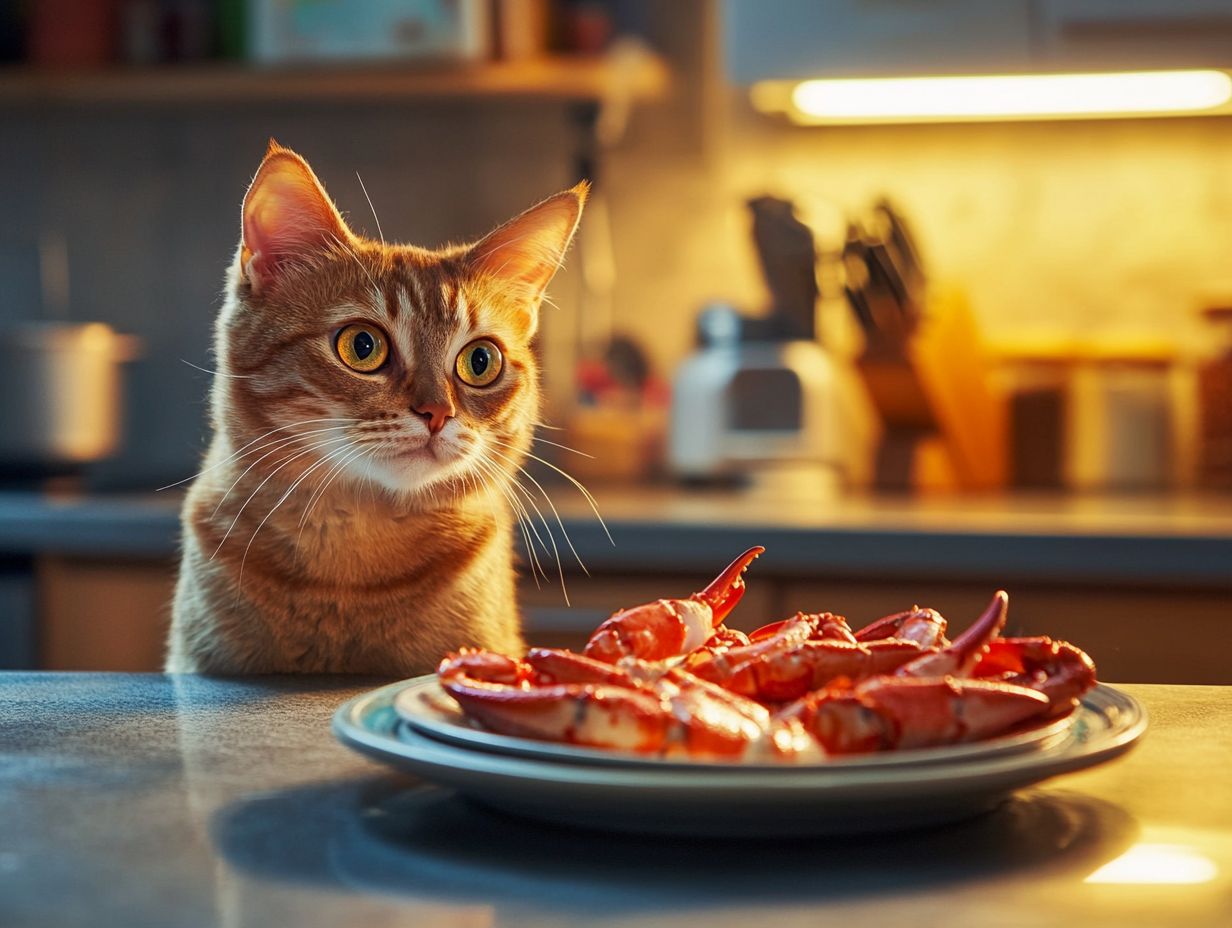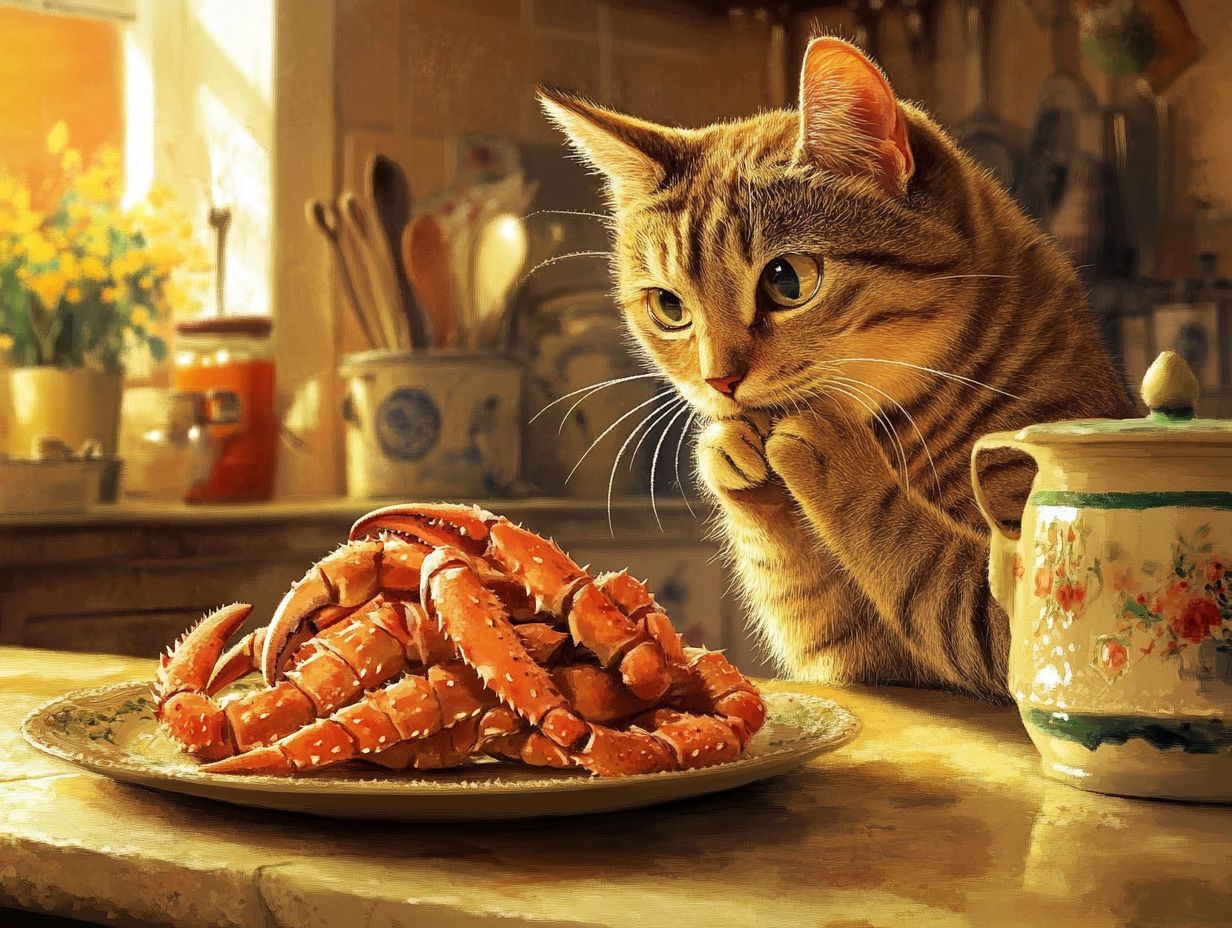Curious about whether your feline friend can eat crab safely? This article explores the complexities of feeding cats this seafood delicacy, including the consideration of imitation crab as a potential treat.
We examine a cat’s nutritional needs, including the dietary benefits of seafood, highlight potential health risks, and provide tips for safe preparation and portion control, ensuring your pet’s health and well-being.
If crab isn’t ideal for your kitty, we suggest some tasty alternatives, such as tuna, salmon, and sardines, which are rich in protein and essential nutrients.
Join us as we uncover the truth about cats and crab, ensuring your pet’s diet is both safe and satisfying!
Key Takeaways:
- Cats can eat crab, but it is not recommended as a regular part of their diet due to potential health concerns.
- Feeding cats crab can lead to digestive issues, allergic reactions, and exposure to harmful bacteria and parasites, such as Salmonella and Listeria.
- If you choose to feed your cat crab, ensure it is properly cooked, served in small portions (1 teaspoon for small cats, up to 1 tablespoon for larger cats), and isn’t the only source of protein in their diet.
Can Cats Eat Crab? A Comprehensive Guide
Cats can eat crab, but it is essential to do so with caution due to potential health risks. Crab can provide some nutritional benefits, but improper feeding practices can lead to serious health issues. This article will explore the benefits and risks of feeding crab to cats, safe feeding guidelines, and alternative seafood options.
Understanding a Cat’s Nutritional Needs
A cat’s nutritional needs primarily consist of proteins and essential nutrients necessary for maintaining a healthy immune system, supporting muscle development, and providing energy. Along with proteins, cats require various vitamins and amino acids.
For example, arginine is an amino acid that plays a crucial role in detoxifying ammonia, while vitamins A and E are vital for maintaining skin health and ensuring proper cell function. Seafood, rich in proteins and omega-3 fatty acids, can significantly enhance a cat’s diet. Incorporating seafood such as mackerel, tuna, sardines, or salmon can provide a delicious and nutritious source of these important elements.
The Risks of Feeding Cats Crab
Crab can be a delicious treat for cats, but pet owners should be aware of several risks associated with feeding crab to their feline companions. These risks include potential health issues caused by toxins, harmful bacteria, and parasites commonly found in shellfish.
Additionally, fish bones can pose a choking hazard. Some types of seafood may contain high levels of mercury and other toxins that could adversely affect your cat’s health. Furthermore, certain cats may experience allergies or sensitivities to shellfish.
Common Symptoms of Allergies
It’s important to monitor your cat for any adverse reactions. Symptoms of shellfish allergies can include:
- Vomiting
- Diarrhea
- Itching or skin irritations
- Swelling
Potential Health Concerns

Crab can pose risks to cats due to exposure to toxins, bacteria such as Salmonella and Listeria, and potential allergic reactions in some cats. Seafood, including crab, may contain elevated levels of mercury and other contaminants, so proper preparation and moderation are essential to ensure it remains a safe occasional treat.
The main concerns associated with feeding crab to cats include:
- Exposure to Contaminants: Crab is classified as a medium-high mercury seafood according to a report by the United States Food and Drug Administration (FDA). While the mercury content can vary widely among different types of crab, it is important to recognize that crabs can also carry toxins. These toxins often stem from industrial wastewater or agricultural runoff and are absorbed by the crabs from their aquatic environment, accumulating in their bodies. Humans and animals that consume contaminated crab may experience harmful effects. Rigorous quality control in the supply chain can help reduce these toxic impurities.
Practical Tips for Feeding Crab to Cats
If you decide to treat your cat to crab, follow these guidelines:
- Limit feeding crab to once a month.
- For small cats, serve a portion of no more than 1 teaspoon of crab meat. For larger cats, up to 1 tablespoon may be appropriate.
- Always ensure the crab is fully cooked and free from seasonings, shells, and additives.
Safe Ways to Feed Cats Crab
To safely feed crab to cats, follow these guidelines:
- Ensure the crab is cooked (steam or boil for at least 10 minutes) and free from harmful ingredients.
- Offer portions of 1-2 small bites and no more than twice a month to prevent digestive upset.
For more detailed information, check out this article on Can Cats Eat Crab? Safe or Harmful for Cats?.
Alternatives to Crab for Cats
If you want to minimize risks, consider alternatives like tuna, salmon, and sardines. These options also provide nutritional benefits.
- Tuna: High in protein but should be offered occasionally due to potential mercury accumulation.
- Salmon: Contains omega-3 fatty acids that support healthy skin and coats.
- Sardines: Great source of calcium for bone health.
When prepared correctly, these seafood options can serve as safe treats and diversify your cat’s diet.
Other Seafood Options

Other seafood options for cats are excellent sources of protein and beneficial fatty acids. Ensure these are offered in moderation and of high quality to avoid harmful effects.
Portions should be limited to maintain a healthy nutritional balance in your cat’s diet.
Conclusion
While crab can be a tasty treat for cats, it is crucial to prioritize safety and moderation when including it in their diet. Always prepare it correctly and opt for safer seafood alternatives when in doubt. Consult your veterinarian for personalized advice on your cat’s dietary needs.
For further engagement, share your experiences about feeding crab to your cat on social media or in the comments below!